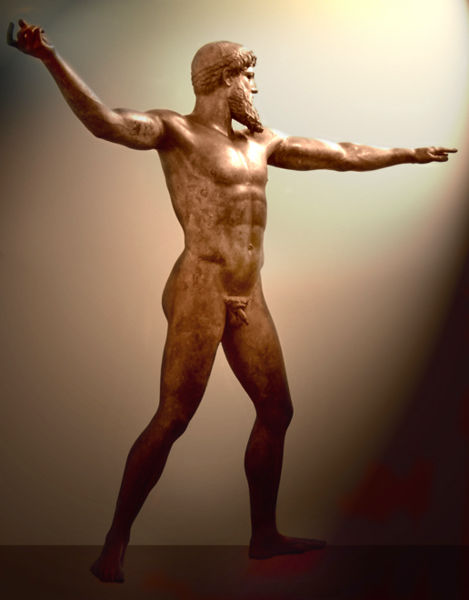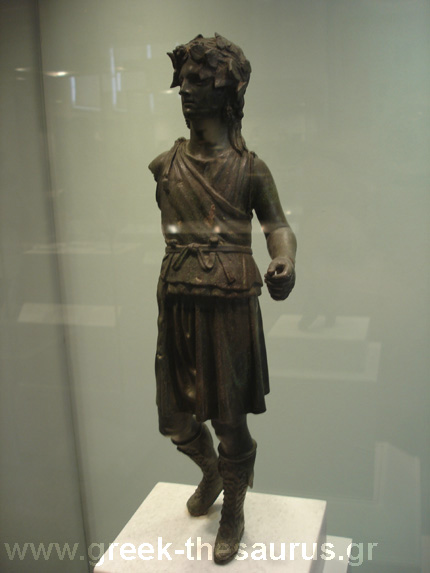There are two distinct periods in the history of ancient Greece, which also have a direct relation to the essence of artistic principles that were being utilized by artists during the course of these periods – Classical and Hellenistic. The Classical period, which lasted from the 6th to 4th century B.C., is being commonly referred to as the peak of Greek aesthetical thought. The artistic masterpieces that are being created during the course of this period promote the concept of existential harmony because, in them, the ideals of physical beauty are organically combined with the ideals of intellectual excellence.
This is especially noticeable in Greek sculptures from this period. The surviving sculptures of Greek philosophers and Gods leave no doubt as to the fact that the ideal of human forms’ physical perfection served as the driving motif behind their creation. The Hellenistic period of Greek art can be characterized by artists’ “realistic” approach within the context of depicting human bodies. Late Hellenistic sculptures do not exploit the motif of physical harmony as their most distinctive feature.
Many of these sculptures depict individuals that are being clearly marked with physical inadequacy – overdeveloped lower jaws, disproportionably large heads, and weak bodily physique. This is because this historical period is associated with the influx of Asiatic aesthesis into European mentality, which was made possible by Alexander’s Great geopolitical policies.
In this paper, we will compare the bronze sculpture of Poseidon, created circa 460 B.C, and the bronze statue of Dionysus, which was created around 150 B.C. The sculpture of Poseidon depicts a harmonically developed nude male, which was originally holding a trident above his head. Poseidon’s facial expression suggests that he is not being affected by any existential weaknesses. He is fully focused on crushing his enemies; however, he also appears as retaining a completely unemotional posture.
Anthropologically speaking, Poseidon clearly belongs to a White race – there is absolutely no evidence that he is being affected by racial mixing. We can say that the sculpture of Poseidon is the physical expression of ancient Greek life philosophy, which emphasizes the fact that physical, intellectual, and aesthetical finesses cannot exist independently of each other. It is clear that the sculpture’s author was using a real individual as a model during the course of producing his masterpiece.
Therefore, Poseidon cannot be thought of as simply an idealized projection of the sculptor’s ideas of what the concept of physical perfection stands for. In fact, the analyzed sculpture is very realistic in its essence. It is hard for us to believe, but the fact is – during the Classical period of ancient Greek history, the majority of citizens in cities-polises were athletes, warriors, and philosophers at the same time. Therefore, even though that sculptures from this historical period appear to us as being unengaged with objective reality, the truth is actually quite the opposite.
The bronze statue of Dionysus from the late Hellenistic period appears as such that promote entirely different existential values. First of all, the physical proportions of Dionysus strike us as not being quite normal – he has a very large head that sits on a long and narrow neck, with his shoulders being almost non-existent. Dionysus seems to be the person who had never held anything heavier than a glass of vine in his hands since he has an utterly weak physical constitution. Despite his young age, Dionysus appears as having developed a bit of “beer belly,” his posture does not emanate any ideas whatsoever.
We cannot explain such dissonance simply by the fact that Dionysus is the God of drinking, which is why overindulgence is a normal type of behavior for him. Apparently, the very essence of esthetic ideals had undergone a transformation during the course of the Hellenistic period. Therefore, it is quite inappropriate to refer to Hellenistic art and being more realistic than Classical art. Just as Classic artists, Hellenistic sculptors continued to strive to depict individuals in a realistic manner. However, since bellyful idleness and indulgence in racial mixing, on the part of many Greeks in that time, had turned them into people affected by physical inadequateness, it comes as no surprise that many late Hellenistic sculptures are being clearly touched by existential degeneracy, as it is the case with a statue of Dionysus.


Bibliography
- Barringer, Judith “Periklean Athens and Its Legacy : Problems and Perspectives”. Austin, TX, USA: University of Texas Press, 2005.
- Reinhold, Meyer. “Studies in Classical History and Society”. Cary, NC, USA: Oxford University Press, Incorporated, 2002.